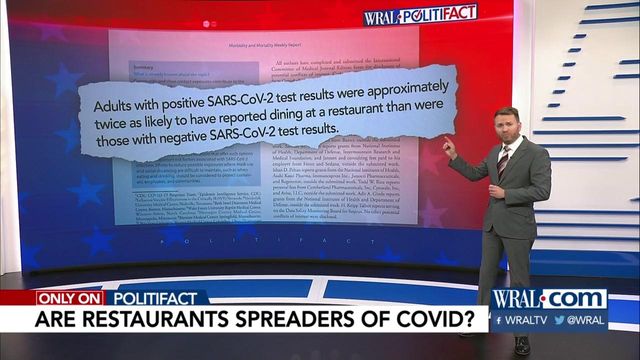Fact check: Fox host falsely says COVID-19 doesn't spread at restaurants
Fox News host Laura Ingraham downplayed the risk of contracting the coronavirus while dining at a restaurant, wrongly claiming restrictions on eating out are not supported by science. "You know what the biggest lie is, is that restaurants are spreaders of COVID," Ingraham told host Sean Hannity during the handoff between their TV shows. "There's no science for that."
Posted — UpdatedFox News host Laura Ingraham downplayed the risk of contracting the coronavirus while dining at a restaurant, wrongly claiming restrictions on eating out are not supported by science.
The Dec. 8 comment came after Hannity made reference to Ingraham’s on-air interview the previous day with a Los Angeles restaurant owner. The owner, Angela Marsden, had posted a viral video criticizing county officials for suspending outdoor dining.
Hannity later specified that he was talking about "outside" dining in California. But Ingraham’s claim about restaurants was far more sweeping — and more wrong. It’s inaccurate to say that "there’s no science" to show "restaurants are spreaders of COVID."
"There is a lot of information showing that restaurants are a high-risk environment," said Emily Landon, an epidemiologist and associate professor of medicine at the University of Chicago.
"Anytime people congregate, there exist increased opportunities for transmission should someone be infected," added Jeffrey Shaman, a professor of environmental health sciences at Columbia University. "A restaurant is no different."
Fox News did not offer comment for this fact-check.
Indoor dining is most risky, studies suggest
"It’s hard to make universal claims because the pandemic is different in different parts of the country and even in different parts of the state," said Amesh Adalja, a senior scholar at the Johns Hopkins University Center for Health Security. "In some parts of the country, restaurants aren’t driving cases. In others, they have been identified in case investigations."
City data in Washington, D.C., for example, has shown restaurants and bars to be among the most common places for virus spread. Data in and around Los Angeles has been less clear.
Still, there’s plenty of evidence that COVID-19 has and can spread at restaurants — and especially at those that let groups of people congregate indoors without masks.
"Modeling studies have indicated that restaurants are high-risk environments for COVID-19 transmission," said Jason McDonald, a spokesperson for the Centers for Disease Control and Prevention. "In places like restaurants, people remove their masks to consume food and beverages, which increases the risk of transmission."
The authors wrote that those with positive test results were "approximately twice as likely to have reported dining at a restaurant" than those who tested negative.
How COVID-19 can spread in restaurants
Dining outdoors is safer than dining indoors, the CDC says, and restaurants with spaced out tables and limited guests are less risky than restaurants that aren’t keeping patrons apart.
The virus is mostly spread from close physical contact, when people are exposed to respiratory droplets sent into the air as an infected person coughs, sneezes, talks, laughs or breathes.
Restaurants can reduce the chance of virus spread. Shaman recommended that they minimize or end indoor dining, limit tables and space them out, require waiters to wear gloves and masks, increase ventilation and keep surfaces clean. He also suggested that restaurants take down contact information for those who dine in case contact tracing needs to be performed.
PolitiFact ruling
Ingraham said, "You know what the biggest lie is, is that restaurants are spreaders of COVID. There's no science for that."
In fact, plenty of evidence suggests restaurant dining has helped spread the coronavirus. Places that allow indoor dining and don’t follow safety protocols are considered especially unsafe.
We rate Ingraham’s statement False.
Related Topics
Copyright 2024 Politifact. All rights reserved.





